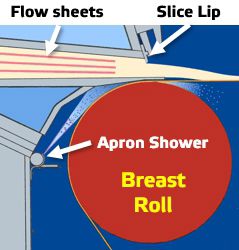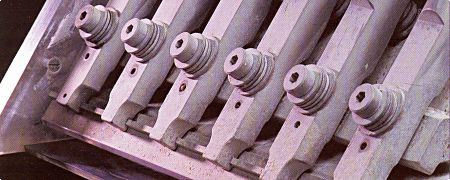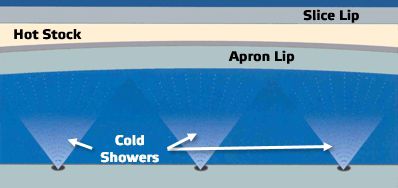Headbox apron shower troubleshooting variables, and a case study

As the name implies, the initial function of the apron shower is to keep the headbox apron clean. It must do this with minimum water volume, full coverage, and without thermal distortion of the projecting apron lip.
Water volume and shower distribution
The headbox apron shower is designed to keep the apron clean - not to clean the apron. Its function is not to dislodge deposited debris, which can be detrimental to the papermaking process, but instead to prevent debris accumulation. To maintain a clean apron lip, showers should be left on at all times while the machine is in operation.
The volume of shower water should be kept to a minimum. Excess water can be detrimental to the papermaking process. All water supplied must be drained off the bottom of the headbox jet at the forming board; excess can disturb the surface and trajectory of the slice jet.
Shower pressure should only be just enough to ensure full coverage and uniform water distribution. Fan shower nozzles are recommended since they provide uniform coverage at minimum volume. They also are reasonably tolerant of solids that may be in the water.
Temperature control
Shower water temperature control is probably the most important feature of the apron shower. From a stability standpoint, it is essential that all sides of the apron lip be of equal and uniform temperature, or thermal distortion may occur. Therefore, shower water temperature must be controlled relative to stock temperature.
Since the apron lip should be the benchmark for any profiling system, it is essential that it be free of distortion in order to function properly. Without a flat apron lip, the profiling system does not have an accurate reference. Many expensive profiling systems are installed without the fundamental consideration of potential thermal distortion of the apron lip. Without shower water temperature control, the profile can change on the run due to temperature variations.
Water purity and nozzle maintenance
One other key variable that determines proper shower use is water purity. To avoid clogging shower nozzles, shower water must be free of contaminants. Nozzles should be inspected frequently for uniformity. Fabric change provides a good opportunity to run the shower and check performance. The showers and the apron surface should be monitored for deposits of dissolved material in the water. Chemical cleaning is usually effective in cleaning these deposits. Rectifier roll headboxes with air cushion in the headvat area require showers to keep interior surfaces clean and kill any foam that may develop on the air-stock interface. Uniformly distributed, temperature-controlled water is desirable for this application to ensure uniform sheet formation. The headvat shower can be connected in parallel with the apron shower; of course, the extra capacity must be added to the heating system.
Case Study: Heavy basis weight edges
A fine paper mill in the United States was plagued with heavy basis weight edges on its fourdrinier machine with a hydraulic headbox. To compensate for the heavy edges, the slice lip was profiled down at the edges. In fact, some of the edge slice lip adjusters were near bend limits just to get rid of thermal distortion. As a result, mill personnel could not make slice lip adjustments to correct day-to-day basis weight variations.

The headbox slice actuators were limited in their ability to adjust the slice.
The mill examined various solutions to this problem but had not concentrated on the apron showers. Some mills frequently overlook the apron lip heat exchanger because other showers that hit the wire are unheated, leading personnel to believe that the breast roll shower does not need to be heated.
Analysis
Three key indicators that a machine has a thermal bow problem in the apron lip are:
- When the jet lands shorter on the edges than in the center of the machine
- When the slice lip is closed up on the edges
- When there is a heavy basis weight at the edges.
The mill in question experienced all three of these indicators but had not made the connection between these problems and the apron showers.
There are many items that can induce a thermal bow in the headbox. Some of these items are
- Water in the headbox slice body or apron lip is improperly set at a controlled temperature
- Temperature-controlled water in the apron lip shower is set at the wrong temperature
- Cross-machine plates near the fabrications that support the slice lip or apron lip are unheated
- Mild steel plates in the apron support fabrication
- Cold, forced air is blowing on the headbox slice body.

Apron shower temperature relative to stock temperature is critical to prevent the apron lip thermal deformation shown here.
At the mill in question, maintenance and supplier personnel found that the apron lip shower was operating at 40 °F lower than the stock temperature. The stainless steel apron lip responded to the differential temperature as expected by bowing toward the heat. As a result, the slice opening was smaller in the center of the machine and greater on the edges. This variation in slice opening was the root cause of the heavy basis weight edges.
Solution was simple
To help the mill, the supplier installed a new heat exchanger on the breast roll shower to control the temperature of the breast roll shower to match the stock temperature within 2 °F. This addition greatly reduced the heavy edges out of the headbox and allowed the slice lip to be used for profiling the basis weight variations.
For more information on headbox apron showers and runnability, contact your Valmet representative.